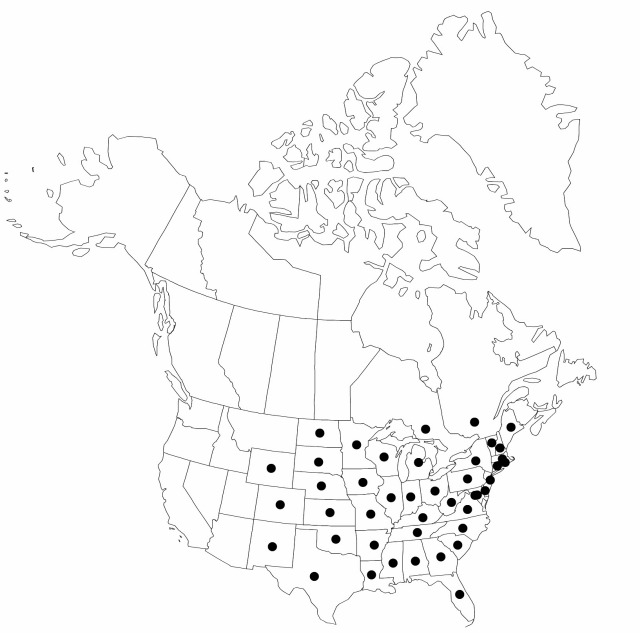Carex blanda
Amer. J. Sci. Arts 10: 45. 1825.
Culms densely tufted, central or lateral, rarely erect, ascending, lax, or, occasionally, decumbent, slightly winged, 14–53 cm × 0.8–1 mm. Leaves: basal sheaths brown or light-brown; sheaths 1–48 mm; blades erect, ascending or lax, green, midrib well developed abaxially, lateral-veins developed adaxially, flat, 14–36 cm × 1–10 mm, blades of overwintering leaves smooth abaxially. Inflorescences: peduncles of proximal absent; of terminal spike 0–1.7 cm. Bracts 0.9–17 cm × 1–8 mm, bract blade of distal lateral spikes linear, narrower than spikes, not concealing them (viewed from abaxial surface), widest bract blade of distalmost lateral spike 0.5–3.4 mm wide. Spikes 4 (–5) per culm; lateral spikes scattered or distal 2 proximate, 15–18 × 3–4 mm; terminal spike overtopping or proximate to proximal pistillate spikes, linear, 9–20 × 1.8–2.4 mm. Pistillate scales 2.8–3 × 1.4–1.6 mm, apex apiculate to aristate, awn to 1.5 mm. Staminate scales 1.8–3.2 × 1.4–1.8 mm, margins hyaline, apex acute or acuminate. Anthers 1.8–2.2 mm. Perigynia 4–18 per spike, closely overlapping, ratio of longer lateral spike length to perigynia number 0.8–1.7, aggregated, ascending, conspicuously (22–) 25–32-veined, obovate to elliptic-obovate, 2.5–3.8 (–4.1) × 1.3–2.2 mm, 1.5–1.9 times as long as achene bodies; beak abruptly bent, 0.2–0.6 mm. Achenes obovoid, 2.1–3.2 × 0.8–1.8 mm. 2n = 30, 32, 34, 36.
Phenology: Fruiting spring–early summer.
Habitat: Wet, moist or dry, open areas or in deciduous or deciduous-evergreen forests, wide range of soil types, frequently weedy
Elevation: 0–1000 m
Distribution

Ont., Que., Ala., Ark., Colo., Conn., Del., D.C., Fla., Ga., Ill., Ind., Iowa, Kans., Ky., La., Maine, Md., Mass., Mich., Minn., Miss., Mo., Nebr., N.H., N.J., N.Mex., N.Y., N.C., N.Dak., Ohio, Okla., Pa., R.I., S.C., S.Dak., Tenn., Tex., Vt., Va., W.Va., Wis., Wyo.
Discussion
Carex blanda is the most common and widespread of all members of sect. Laxiflorae. It is often locally abundant and capable of being somewhat weedy in areas where it is frequent. It growns in the most diverse environmental and edaphic conditions of all members of sect. Laxiflorae. Plants of C. blanda from drier or wetter habitats usually produce narrower leaves and/or culms than plants from mesic or shaded habitats. Additional research is needed to determine if these are simply expressions due to environment and edaphic conditions or a complex of closely related species or varieties.
Selected References
None.
Lower Taxa
"shortened" is not a number.No values specified.
